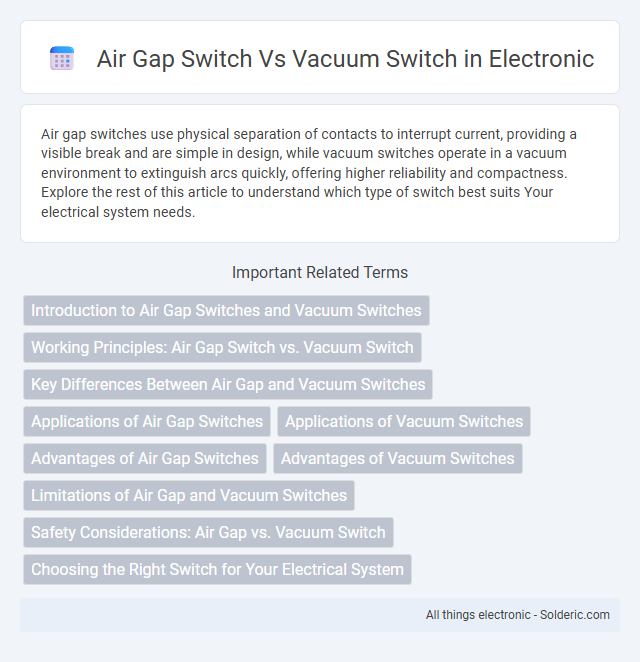Air gap switches use physical separation of contacts to interrupt current, providing a visible break and are simple in design, while vacuum switches operate in a vacuum environment to extinguish arcs quickly, offering higher reliability and compactness. Explore the rest of this article to understand which type of switch best suits Your electrical system needs.
Comparison Table
| Feature | Air Gap Switch | Vacuum Switch |
|---|---|---|
| Operating Principle | Interrupts current by creating an air gap | Extinguishes arc in a vacuum |
| Arc Quenching Medium | Air | Vacuum |
| Voltage Rating | Up to medium voltage levels | Medium to high voltage applications |
| Contact Wear | High due to arcing in air | Low due to vacuum arc suppression |
| Maintenance | Frequent contact inspection and cleaning | Low maintenance |
| Size | Generally larger | Compact design |
| Applications | Simple open/close operations, isolation switches | High-speed switching, circuit interruption |
| Cost | Lower initial cost | Higher initial cost |
Introduction to Air Gap Switches and Vacuum Switches
Air gap switches use a physical gap to interrupt the electrical circuit, providing a visible and reliable means of isolation for maintenance and safety purposes in electrical systems. Vacuum switches operate by extinguishing the arc within a vacuum chamber, offering compact, high-speed switching with minimal contact wear and maintenance requirements. Both technologies are crucial for controlling and protecting electrical circuits, with air gap switches preferred for clear isolation and vacuum switches favored for high voltage and fast switching applications.
Working Principles: Air Gap Switch vs. Vacuum Switch
Air gap switches operate by physically separating contacts in open air to interrupt electrical current, relying on the air's insulating properties to extinguish the arc. Vacuum switches extinguish arcs within a sealed vacuum chamber where the absence of air prevents ionization and rapidly dissipates the arc energy. The vacuum switch design allows for faster arc quenching and higher dielectric strength compared to the traditional air gap switch.
Key Differences Between Air Gap and Vacuum Switches
Air gap switches use a physical separation of contacts to prevent electrical flow, providing a visible and safe isolation point, while vacuum switches utilize a vacuum-sealed chamber to extinguish arcs quickly and efficiently during circuit interruption. The dielectric strength of vacuum switches allows faster arc suppression and smaller size, making them preferable in high-voltage environments compared to the bulkier and mechanically simpler air gap switches. Maintenance requirements differ as well; air gap switches are easier to inspect visually but susceptible to environmental contaminants, whereas vacuum switches are sealed, offering longer operational life and reduced risk of contamination.
Applications of Air Gap Switches
Air gap switches are primarily used in high-voltage applications such as power distribution and industrial electrical systems to physically isolate electrical circuits for maintenance and safety. They provide visible isolation, ensuring that circuits are completely de-energized before any work is performed, which is essential in substations and large-scale manufacturing plants. Their robust design makes them suitable for outdoor environments and harsh conditions where reliable disconnection is critical.
Applications of Vacuum Switches
Vacuum switches are widely used in industrial automation, HVAC systems, and electrical power distribution due to their high dielectric strength and reliable arc-quenching capabilities. Their sealed vacuum environment prevents contamination and prolongs the lifespan of contacts, making them ideal for high-voltage circuit protection in power plants and substations. Applications also include control circuits in manufacturing processes where compact, maintenance-free switching is critical.
Advantages of Air Gap Switches
Air gap switches provide superior isolation by physically separating circuit contacts, ensuring zero electrical continuity and eliminating risk of arcing, which enhances safety and reliability in high-voltage applications. Their simple, robust design offers easy maintenance and long service life with fewer failures compared to vacuum switches that rely on sealed environments. Air gap switches are highly effective for disconnecting power lines during maintenance or faults, making them ideal for outdoor and industrial environments where visible break confirmation is critical.
Advantages of Vacuum Switches
Vacuum switches offer superior arc quenching capabilities compared to air gap switches, resulting in faster interruption of electrical currents and reduced contact wear. Their compact design enables installation in confined spaces, making them ideal for modern electrical systems with limited room. Vacuum switches provide enhanced dielectric strength and minimal maintenance requirements, ensuring greater reliability and longer operational lifespan in high-voltage applications.
Limitations of Air Gap and Vacuum Switches
Air gap switches have limitations in interrupting high fault currents due to their physical contact separation, causing potential arcing and slower operation speeds. Vacuum switches, while effective at quenching arcs in compact spaces, are limited by dielectric strength constraints that affect their performance in extremely high voltage applications. Understanding these limitations helps you select the appropriate switching device for specific electrical systems, ensuring safety and reliability.
Safety Considerations: Air Gap vs. Vacuum Switch
Air gap switches provide a visible and reliable physical separation that ensures maximum safety by preventing accidental electrical contact during maintenance. Vacuum switches utilize a vacuum-sealed environment to extinguish arcs quickly, minimizing arc flash hazards and offering enhanced protection in high-voltage applications. Both switches prioritize safety, but air gap switches offer clear isolation, while vacuum switches excel in rapid arc suppression and compact design.
Choosing the Right Switch for Your Electrical System
Choosing the right switch for your electrical system depends on factors like voltage rating, interrupting capacity, and environmental conditions. Air gap switches offer simple mechanical isolation with visible disconnection, ideal for safety verification in low-voltage systems, while vacuum switches provide high-voltage interruption with minimal arc duration and compact design, suitable for industrial applications. Evaluating your system's load requirements and maintenance preferences ensures optimal performance and long-term reliability.
air gap switch vs vacuum switch Infographic

 solderic.com
solderic.com